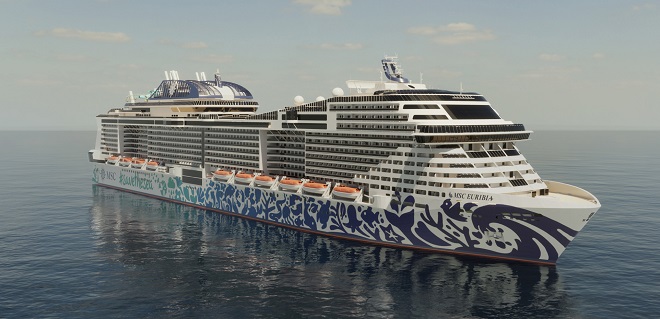“地中海神女”号开启首次温室气体“净零排放”航行
To sail world-first net zero greenhouse gas emissions cruise
发布者:KnowMi 发布时间: 2023-06-08 01:06:17 点击量: 1976 来源:Offshore-energy

5月31日,地中海邮轮(MSC Cruises)旗下的最新一艘邮轮“地中海神女(MSC Euribia)”号正式交付。“地中海神女”号堪称目前最环保的邮轮,她是“传奇”级的最后一艘,使用液化天然气作为主要燃料,并且运用了一系列先进的环保技术。地中海邮轮计划通过“地中海神女”号从圣纳泽尔到哥本哈根为期4天的首航,向外界展示绿色航行的未来。这次航行也将成为邮轮业的首次温室气体“净零排放”航行。“地中海神女”号独特的推进系统设计,使其最大航速达到22.3节的同时,还能拥有出色的节能减排表现。地中海邮轮表示,在航行期间,该船的日均每人温室气体排放量较其使用传统燃料的姊妹船减少19%。与10前建造的船舶相比,这一数值更是下降了44%。
MSC Cruises took delivery on its newest cruise ship on May 31 promoting it as possibly the industry’s most environmentally advanced ship to date. The last ship of a previous class, the MSC Euribia incorporates new elements including the use of LNG as its primary fuel and advanced technologies as the company prepares to demonstrate the future with a four-day delivery voyage from France to Copenhagen. The voyage is being promoted as the world’s first net-zero greenhouse gas emissions trip for a cruise ship. The propulsion plant is designed to give her a maximum speed of 22.3 knots while also being energy efficient and reducing emissions. According to MSC, when in service, the vessel will emit up to 19 percent less greenhouse gas emissions per passenger per day than her sisterships which use conventional marine fuels. This amounts to 44 percent less greenhouse gas emissions per passenger per day than ships built only 10 years ago.
看新闻丨学英语
propeller n. 螺旋桨,推进器
美/prəˈpelər/ 英/prəˈpelə(r)/
Propeller源于动词propel。前缀pro-表“向前”,词根-pel,来源于拉丁语 pellere,现意为“推动;驱赶”。propel源自拉丁语propellere,意为“推动;推进”,指用力将物体推向前方,加上后缀-er则表示“与推进相关的事物”,即“推进器”。
船舶推进器是船舶上提供推力的装置,它的作用是将能源(发动机)提供的动力转换成推力,推动船舶前进。最常见的推进器是螺旋桨,它靠桨叶在空气或水中旋转,将发动机转动功率转化为推进力,可分为定(桨)距和变距螺旋桨两大类。
knot 节 n.(绳等的)结;海里/小时
美/nɑːt/ 英/nɒt/
Knot来源于古英语cnotta。16世纪时,为了计算船的航行速度,水手会在绳子末端绑上木块,并按照均等长度打结,以数绳结的方式来计算航行速度。
节,单位符号kn,是一个专用于航海的速率单位,后延伸至航空领域,指船舶或飞机每小时所航行的海里数。1节=1海里/小时=1.852公里/小时=0.514444m/s 。海里是航海上的长度单位,它原指地球上纬度1分的长度,由于地球略呈椭球体状,因此在不同纬度的1分其弧度略有差异。